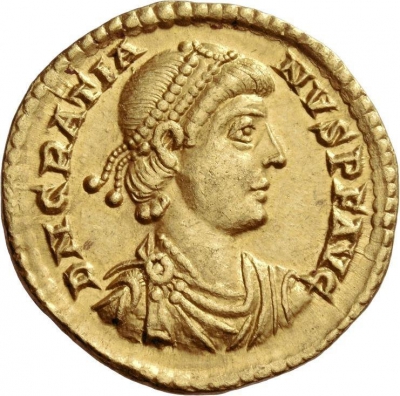Theodosius I (Greek: Theodsios; 11 January 347 17 January 395), also called Theodosius the Great, was Roman emperor from 379 to 395. During his reign, he succeeded in a crucial war against the Goths, as well as in two civil wars, and was instrumental in establishing the creed of Nicaea as the doctrine for Christianity. Theodosius was the last emperor to rule the entire Roman Empire before its administration was permanently split between two separate courts (one western, the other eastern).
Born in Hispania, Theodosius was the son of a high-ranking general under whose guidance he rose through the ranks of the Roman Army. Theodosius held independent command in Moesia in 374, where he had some success against the invading Sarmatians. Not long afterwards, he was forced into retirement, and his father was executed under obscure circumstances. Theodosius soon regained his position following a series of intrigues and executions at the emperor Gratian's court. In 379, after the eastern Roman emperor Valens perished at the Battle of Adrianople against the Goths, Gratian appointed Theodosius as a successor with orders to take charge of the current military emergency. The new emperor's resources, and depleted armies, were not sufficient to drive the invaders out; in 382 the Goths were allowed to settle south of the Danube as autonomous allies of the Empire. In 386, Theodosius signed a treaty with the Sasanian Empire which partitioned the long-disputed Kingdom of Armenia and secured a durable peace between the two powers.Theodosius was a strong adherent of the Christian doctrine of consubstantiality and an opponent of Arianism. He convened a council of bishops at Constantinople in 381 which confirmed the former as orthodoxy and the latter as a heresy. Although Theodosius interfered little in the functioning of traditional pagan cults and appointed non-Christians to high offices, he failed to prevent or punish the damaging of several Hellenistic temples of classical antiquity, such as the Serapeum of Alexandria, by Christian zealots. During his earlier reign, Theodosius ruled the eastern provinces, while the west was overseen by the emperors Gratian and Valentinian II, whose sister he married. Theodosius sponsored several measures to improve his capital and main residence, Constantinople, most notably his expansion of the Forum Tauri, which became the biggest public square known in antiquity. Theodosius marched west twice, in 388 and 394, after both Gratian and Valentinian had been killed, to defeat the two pretenders, Magnus Maximus and Eugenius, that rose to replace them. Theodosius's final victory in September 394 made him master of the Empire; he died a few months later and was succeeded by his two sons, Arcadius in the eastern half of the empire and Honorius in the west.
Theodosius was said to have been a diligent administrator, austere in his habits, merciful, and a devout Christian. For centuries after his death, Theodosius was regarded as a champion of Christian orthodoxy who decisively stamped out paganism. Modern scholars tend to see this as an interpretation of history by Christian writers more than an accurate representation of actual history. He is fairly credited with presiding over a revival in classical art that some historians have termed a "Theodosian renaissance". Although his pacification of the Goths secured peace for the Empire during his lifetime, their status as an autonomous entity within Roman borders caused problems for succeeding emperors. Theodosius has also received criticism for defending his own dynastic interests at the cost of two civil wars. His two sons proved weak and incapable rulers, and they presided over a period of foreign invasions and court intrigues which heavily weakened the Empire. The descendants of Theodosius ruled the Roman world for the next six decades, and the eastwest division endured until the fall of the Western Empire in the late 5th century.
Gratian (; Latin: Flavius Gratianus; 18 April 359 – 25 August 383) was emperor of the western part of the Roman Empire from 367 to 383. The eldest son of Valentinian I, Gratian accompanied his father on several campaigns along the Rhine and Danube frontiers and was raised to the rank of augustus in 367. Upon the death of Valentinian in 375, Gratian took over government of the west while his half-brother Valentinian II was also acclaimed emperor in Pannonia. Gratian governed the western provinces of the empire, while his uncle Valens was already the emperor over the east.
Gratian subsequently led a campaign across the Rhine, attacked the Lentienses, and forced the tribe to surrender. That same year, the eastern emperor Valens was killed fighting the Goths at the Battle of Adrianople, which led to Gratian elevating Theodosius to replace him in 379. Gratian favoured Nicene Christianity over traditional Roman religion, issuing the Edict of Thessalonica, refusing the office of pontifex maximus, and removing the Altar of Victory from the Roman Senate's Curia Julia. The city of Cularo on the Isère river in Roman Gaul was renamed Latin: Gratianopolis after him, which later evolved to Grenoble.
In 383, faced with rebellion by the usurper Magnus Maximus, Gratian marched his army towards Lutetia (Paris). His army deserted him. He fled to Lyon and was later murdered.

 English
English  español
español  français
français  português
português  русский
русский  العربية
العربية  简体中文
简体中文 
